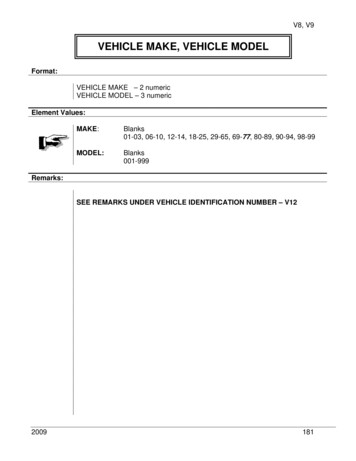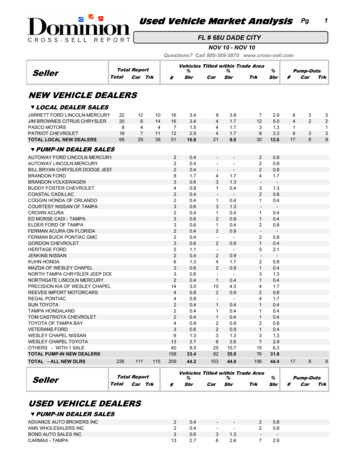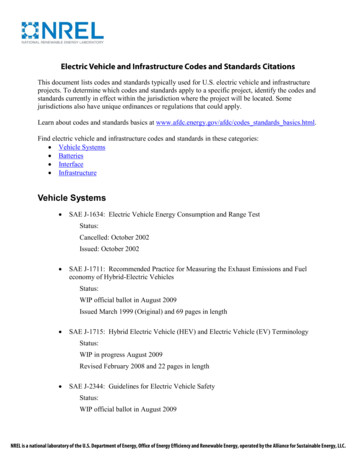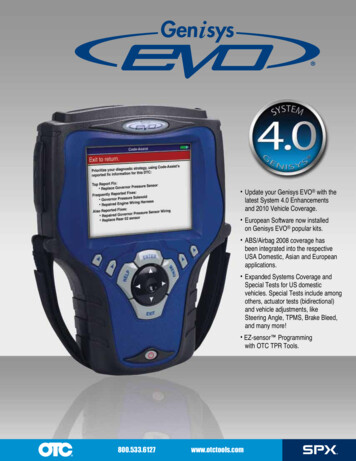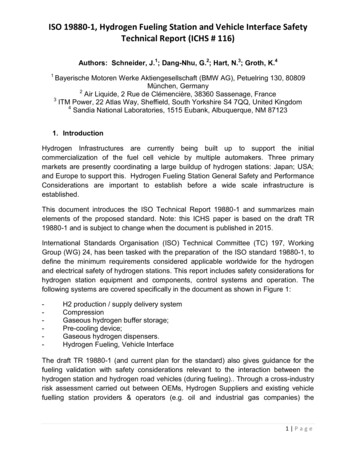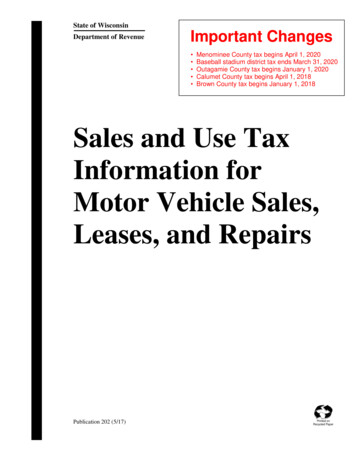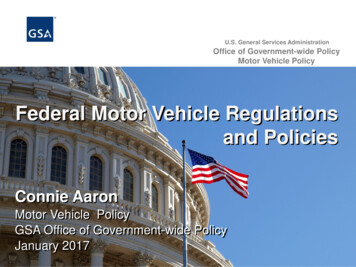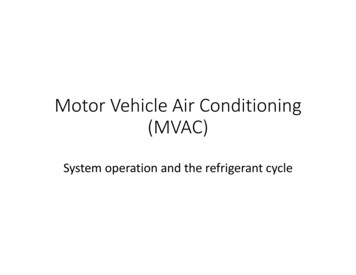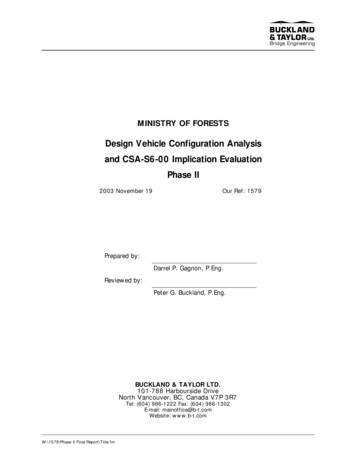
Transcription
BUCKL AND& TAYLOR LTD.Bridge EngineeringMINISTRY OF FORESTSDesign Vehicle Configuration Analysisand CSA-S6-00 Implication EvaluationPhase II2003 November 19Our Ref: 1579Prepared by:Darrel P. Gagnon, P.Eng.Reviewed by:Peter G. Buckland, P.Eng.BUCKLAND & TAYLOR LTD.101-788 Harbourside DriveNorth Vancouver, BC, Canada V7P 3R7Tel: (604) 986-1222 Fax: (604) 986-1302E-mail: mainoffice@b-t.comWebsite: www.b-t.comW:\1579\Phase II Final Report\Title.fm
BUCKL AND& TAYLOR LTD.Bridge EngineeringExecutive SummaryThe Ministry of Forests (BCMoF) had previously commissioned Buckland & Taylor Ltd. toconduct of review of the Forest Service Bridge Design and Construction Manual and CAN/CSA-S6-00 (CHBDC) to determine if the existing BCMoF Design Vehicle configurations arereasonably representative of the logging vehicles now being used in the BC forest industryand if these configurations are appropriate for use with the load factors in CHBDC.A survey of logging truck weights conducted by Forest Engineering Research Institute ofCanada (FERIC) provided the base data for this analysis and the results of this study werepresented to the BCMoF in a report entitled ’MoF Design Vehicle Configuration Analysis andCSA-S6-00 Implication Evaluation’ dated 2003 January 04 (draft report dated 2002 May13). Although the report made some recommendations for revisions to the L75 DesignVehicle and corresponding load factors, it was concluded that insufficient data was availableto accurately assess the L100, L150 and L165 Design Vehicles or trucks conductingmovements of logging equipment. Although truck loadings and bridge design capacityrequirements could vary significantly between operationing regions and individual operators,comments received from personnel involved in the industry indicated that most companieswere having forestry bridges designed for load levels that exceeded the maximum measuredweights of most of the logging trucks.The BCMoF subsequently engaged FERIC to conduct a survey of forest companies to obtainthe required additional data on logging truck weights and to determine the design capacitiesrequired by the forest companies in various regions of the province. The BCMoF alsoextended Buckland & Taylor Ltd.’s original assignment to include the assessment of this newdata.The additional survey data on the gross vehicle weights of the logging trucks operating inboth the Interior and Coastal regions of BC was analyzed and was considered to beappropriate for use in the derivation of live load factors. Live load factors were derived forthe L100 (Interior region) plus the L150 and L165 (Coastal region) Design Vehicleconfigurations as these are the design loadings specified for most bridges in the province.Bridge components designed for the L100 and L150 Design Vehicles were found to beslightly deficient if governed by short span loadings (axle groups) and somewhat overdesigned if governed by longer span loadings (gross vehicle weights). This is similar to thefindings for the L75 Design Vehicles in the previous phase of this study. The L165 DesignVehicle was found to provide conservative bridge designs on both short and longer spans forthe current population of logging trucks transiting these bridges.15792003 November 19Design Vehicle Configuration Analysis andCSA-S6-00 Implication Evaluation - Phase II
BUCKL AND& TAYLOR LTD.Bridge EngineeringThe derived live load factors varied significantly for bridge components governed by shortspan loadings and those by long span loadings. In addition, significant variation wasobserved in the live load factors derived for the various Design Vehicle Configurations.Therefore, the application of a single live load factor for all design cases will result in casesof under and over design of bridge components. Modifications to the existing Design VehicleConfiguration weight and distributions of weights to the axles are required to allow the useof a single live load factor for all design cases. Modified Design Vehicle Configurations weredeveloped for use with the 1.7 live load factor specified by CHBDC. The adoption of 1.7 asthe live load factor would also allow the direct use of the provisions of CHBDC for the designof forestry bridges.The CL-W configuration from CHBDC was also assessed as an alternative loading model butwas also found to require significant modification to provide a consistent level of safety forall bridge span lengths.Theoretical loadings for lowbed trucks transporting logging equipment were assessed andthe base characteristics of these loadings were found to be similar to those for overloadtrucks operating on the highway. Therefore, it is recommended that the provision of Section14 of CHBDC pertaining to permit trucks be used to assess the acceptability of these truckson forestry bridges. The lowbed truck weights developed for this study did not appear togovern over the Design Vehicle for the design of the bridges. However, bridge operator maywish to provide additional bridge capacity to allow for somewhat heavier lowbed trucks thatmay operate currently or in the future.Design Vehicle Configuration Analysis andCSA-S6-00 Implication Evaluation - Phase II15792003 November 19
Table of Contents1Introduction . . . . . . . . . . . . . . . . . . . . . . . . . . . . . . . . . . . . . . . . . . . . . . 12Methodology . . . . . . . . .2.1 General . . . . . . . . .2.2 Study Procedures . .2.3 Limitations of Study.33343Survey of Logging Trucks . . . . . . . . . . . .3.1 Phase I Data Collection . . . . . . . . . .3.2 Phase II Data Collection. . . . . . . . . .3.3 Collected Data . . . . . . . . . . . . . . . .3.3.1 Data Interior Region . . . . . . .3.3.2 Data Coastal Region. . . . . . .3.3.3 Logging Equipment Moves . .3.4 Discussion of Survey Data . . . . . . . .3.4.1 Interior Region . . . . . . . . . . .3.4.2 Coastal Region . . . . . . . . . .3.4.3 Short Spans and Other Spans.5556677101012144Analysis of Logging Truck Data . . . . .4.1 General Methodology . . . . . . . .4.2 Interior Region . . . . . . . . . . . . .4.3 Coastal Region . . . . . . . . . . . . .4.4 Transport of Logging Equipment .4.4.1 Interior Region . . . . . . . .4.4.2 Coastal Region . . . . . . . 151516171818195Derivation of Logging Truck Load Factors . . . . . . . . . . . . . . . .5.1 General . . . . . . . . . . . . . . . . . . . . . . . . . . . . . . . . . . . .5.2 Other Statistical Parameters . . . . . . . . . . . . . . . . . . . . . .5.3 Live Load Factor Interior Region . . . . . . . . . . . . . . . . . . .5.4 Live Load Factors Coastal Region . . . . . . . . . . . . . . . . . .5.5 Live Load Factor for Transportation of Logging Equipment . 2020202122226Discussion of Design Models and Load Factors . . .6.1 Level of Safety Provided by Current Forestry6.2 BCMoF Design Vehicles. . . . . . . . . . . . . . .6.3 Comparison to CHBDC Design Provisions. . .6.4 Transportation of Logging Equipment . . . . .6.5 Bridge Decks . . . . . . . . . . . . . . . . . . . . . .6.6 Future Changes in Forestry Truck Traffic . . . 2424252730303115792003 November 19.Standard.Design Vehicle Configuration Analysis andCSA-S6-00 Implication Evaluation - Phase II.i
BUCKL AND& TAYLOR LTD.Bridge Engineering7Conclusions and Recommendations . . . . . . . . . . . . . . . . . . . . . . . . . . . . . 328References . . . . . . . . . . . . . . . . . . . . . . . . . . . . . . . . . . . . . . . . . . . . . . 34Appendix AInterior Region Truck Weight Summaries . . . . . . . . . . . . . . . . . . . . . . . . . . . . . iAppendix BCoastal Region Truck Weight Summaries . . . . . . . . . . . . . . . . . . . . . . . . . . . . .iiiAppendix CLogging Equipment Transport Data . . . . . . . . . . . . . . . . . . . . . . . . . . . . . . . . . viiDesign Vehicle Configuration Analysis andCSA-S6-00 Implication Evaluation - Phase II15792003 November 19
BUCKL AND& TAYLOR LTD.Bridge Engineering1IntroductionThe Ministry of Forests (BCMoF) had previously commissioned Buckland & TaylorLtd. to conduct a review of the Forest Service Bridge Design and ConstructionManual and CAN/CSA-S6-00 (CHBDC) to determine the following: Do the existing BCMoF Design Vehicle Configurations produce force effectenvelopes that are reasonably representative for the logging vehicles nowbeing used in the British Columbia forest industry?Are the existing BCMoF Design Vehicle Configurations appropriate for usewith the load factors in CHBDC?The results of this study were presented in a report to BCMoF entitled’ MoFDesign Vehicle Configuration Analysis and CSA-S6-00 Implication Evaluation’dated 2003 January 04 (draft report dated 2002 May 13) [1]. The report maderecommendations for revisions to the L75 Design Vehicle load model and to thecorresponding load factors. However, the study concluded that the data providedwas insufficient to properly assess the appropriateness of the BCMoF DesignVehicles for L100, L150 and L165 loadings for the logging trucks currently usingthe forestry road system. In addition, no information had been obtained todescribe the trucks transporting logging equipment on forestry roads.On 2002 September 10, a seminar was held to present the study findings to anumber of invited personnel from BCMoF, Ministry of Transportation and fromseveral other companies or organizations involved with forestry bridges. Inputreceived from the seminar attendees indicated that although minimum loadcarrying capacities for the design of forestry bridges were not imposed on theforest companies, generally forestry companies were having bridges designed forload levels that exceeded the maximum measured weights of most of the loggingtrucks.The BCMoF subsequently engaged the Forest Engineering Research Institute ofCanada (FERIC) to survey forestry companies to obtain weigh scale informationthat describes the gross vehicle weights of the logging vehicles operating invarious regions of the province and to determine company policy and practicesregarding the load capacity levels required for their bridges. In addition, FERICsurvey the operators of low bed trucks conducting the movements of loggingequipment to determine the configurations of the trucks and typical weights ofequipment being transported.15792003 November 19Design Vehicle Configuration Analysis andCSA-S6-00 Implication Evaluation - Phase II1
BUCKL AND& TAYLOR LTD.Bridge EngineeringThe BCMoF has extended Buckland & Taylor Ltd.’s original assignment to analyzethe new data collected by FERIC and to reassess the appropriateness of theexisting BCMoF Design Vehicle Configurations and to determine if theseconfigurations are appropriate for use with the provisions of CAN/CSA-S6-00(CHBDC) [2]. If appropriate, recommendations for revisions to the BCMoF DesignConfigurations and applicable load factors are to be provided. Similarly,information pertaining to trucks conducting logging equipment moves is assessedand recommendations developed for assessing the suitability of these types ofloads on forestry bridges.A draft report detailing the findings of this study was issued to the BCMoF on2003 June 27. BCMoF distributed the draft report to various forestry relatedcompanies or individuals for review and comment. Written comments werereceived from Mr. Allan Bradley, P.Eng., of FERIC and Mr. Paul King, P.Eng., ofRapid-Span Structures Ltd. Subsequently, the report was modified to addressthese comments.2Design Vehicle Configuration Analysis andCSA-S6-00 Implication Analysis - Phase II15792003 November 19
BUCKL AND& TAYLOR LTD.Bridge Engineering2Methodology2.1GeneralFor a bridge design standard to provide the desired level of safety, it is essentialthat all aspects governing the design process are considered in a consistentmanner. The level of safety provided is dependent on the variations andinterrelationships between the various bridge loadings, member resistances andstructural behaviours of the bridge system. The level of safety provided can besignificantly affected if modifications are made to any of the design requirementswithout considering the impact on the overall design philosophy.The load factors provided by a bridge design standard are typically based on theexpected statistical variations of the actual bridge loadings from the specifieddesign loads. New truck configurations or changes in the level of weightenforcement can significantly alter these statistics and change the level of safetyprovided. Measurements of the actual truck populations being considered arerequired to assess the appropriateness of the requirements in the design standard.This study does not consider fatigue loadings.2.2Study ProceduresThe logging truck weight data provided by FERIC has been used to assess the levelof safety provided by the current BCFS Vehicle Configurations for L100, L150 andL165 type forestry bridges [3]. The following describes the general methodologyused for this study: 15792003 November 19Each set of the logging truck weight data provided is analyzed to determineif the data is reasonably consistent with the other data sets and to identifyand investigate potential outliers in the data. All compatible data sets arecombined to produce an overall data set of logging truck weights for boththe Coastal and Interior regions. The overall data set is compared to the truckweight data
Design Vehicle Configuration Analysis and CSA-S6-00 Implication Evaluation Phase II 2003 November 19 Our Ref: 1579 Prepared by: Darrel P. Gagnon, P.Eng. Reviewed by: Peter G. Buckland, P.Eng. 1579 Design Vehicle Configuration Analysis and 2003 November 19 CSA-S6-00 Implication Evaluation - Phase II AND &TAYLOR BUCKL LTD. Bridge Engineering Executive Summary The
